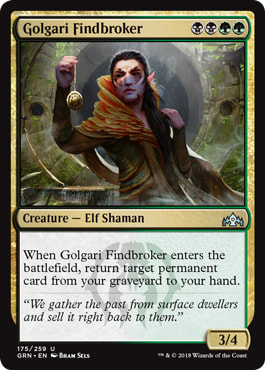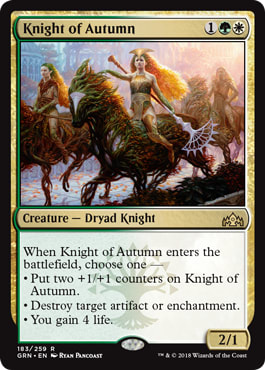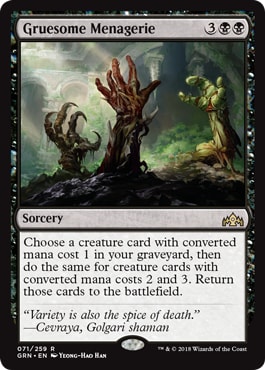Golgari seems to be taking Standard by storm, and it is somewhat easy to understand why. While Golgari has been given a near-universal panning in draft, in Constructed it is a different story altogether.
With the push of the five guilds of Guilds of Ravnica, it is only natural that any color combinations that are emphasized in that set are going to get a huge bump in Constructed. This last weekend, the online Standard PTQ drew 322 competitors, 26 of whom had a record of 7-2 or better, sufficient to Top 8. Here is the breakdown of color combinations for that 26:
![]()
![]() : 6
: 6
![]()
![]() : 6
: 6
![]()
![]()
![]() : 2
: 2
![]()
![]()
![]() : 2
: 2
![]()
![]() : 2
: 2
![]()
![]()
![]() : 2
: 2
![]()
![]()
![]() : 1
: 1
![]()
![]() : 1
: 1
![]() : 1
: 1
![]()
![]() : 1
: 1
![]()
![]()
![]() : 1
: 1
![]()
![]() : 1
: 1
If you break this down into Guild representation, you get:
Golgari: 9
Boros: 7
Dimir: 6
Izzet: 5
Azorius: 4
Orzhov: 4
Selesnya: 3
Rakdos: 2
Simic: 1
Gruul: 0
Poor Gruul, your time will come. Dearest Simic, I have hopes for you eventually... Only sad Selesnya, of the Guilds of Ravnica guilds, is not in the top of representation. While all of these guilds get a major bump from something very simple - lands - some step up to the top.
What puts Golgari at the top? Even if we decide to shoehorn the Mono-Red deck into the "Boros" camp, Golgari still takes the top billing.
Let's look at the winner of the most recent Magic Online PTQ for some inspiration:
Golgari Midrange Control | Guilds of Ravnica Standard | yamakiller, 1st Place Magic Online PTQ
- Creatures (21)
- 1 District Guide
- 2 Plaguecrafter
- 3 Golgari Findbroker
- 3 Ravenous Chupacabra
- 4 Jadelight Ranger
- 4 Llanowar Elves
- 4 Merfolk Branchwalker
- Planeswalkers (7)
- 1 Vivien Reid
- 3 Vraska, Golgari Queen
- 3 Vraska, Relic Seeker
- Instants (6)
- 2 Cast Down
- 4 Assassin's Trophy
- Enchantments (2)
- 2 The Eldest Reborn
- Lands (24)
- 8 Forest
- 8 Swamp
- 4 Overgrown Tomb
- 4 Woodland Cemetery
- Sideboard (15)
- 2 Arguel's Blood Fast
- 3 Dead Weight
- 1 Deathgorge Scavenger
- 4 Duress
- 2 Golden Demise
- 1 Plague Mare
- 1 Vraska's Contempt
- 1 Wildgrowth Walker
We can call it by its technical name - Golgari Midrange Control - or we can simplify it and go old school: this is The Rock.
Get ready to grind. Jadelight Ranger, Merfolk Branchwalker, Ravenous Chupacabra, and even District Guide all bring at least the possibility of card advantage attached to a body, but when you put on top of it seven planeswalkers that do the same thing, The Eldest Reborn doing it even more, and then Golgari Findbroker which takes that "possibility" of card advantage and extends it out to an infinite horizon, you end up with a deck that isn't going to be fun to go long against. Six instant removal can help take you to a mid-game, which can easily translate to a long game, and Llanowar Elves can propel you out of the early game quickly as well.
The Guilds of Ravnica cards are quite relevant.
Assassin's Trophy gives up some of that card advantage, certainly, but with this deck grasping so much already, it doesn't feel particularly relevant. Just being able to answer nearly anything takes pressure off of the rest of the deck to have more specific cards. Options are always important, and the versatility this card gives is huge.
Golgari Findbroker isn't just responsible for giving the deck an absurd end-game, but it is also a huge body. Aggressive decks can struggle to knock this elf down, and controlling decks may find that the combination of the extra card advantage plus a body can be a challenge; it isn't unusual to see Golgari Findbroker alongside a large Jadelight Ranger, with some powerful card in hand to follow up because of the Findbroker's enters the battlefield ability.
Plaguecrafter nicely supplements The Eldest Reborn in punishing decks, especially controlling decks, that run few creatures or planeswalkers. It can be daunting to play a Teferi, Hero of Dominaria, Karn, Scion of Urza, or Doom Whisperer alone onto a board, knowing that there are so many cards that might just immediately knock it down.
Vraska, Golgari Queen will generally come into play and just take out something small, but even if it doesn't, and it is "only" filtering the card draw (not "officially" gaining card advantage), starting at six loyalty after the first activation will put a game quickly in danger of ending with Vraska's ultimate ability.
Finally, District Guide might seem small, especially given the abundance of land that is likely to be found by the deck's Merfolk explorers, but remember that Charles Gindy won PT Hollywood in a sea full of Faeries with a ![]()
![]() Elf deck that ran four Civic Wayfinder.
Elf deck that ran four Civic Wayfinder.
In the course of the Top 8, this deck didn't lose a game. In the quarterfinals, it took down an Izzet Control deck, followed by a Jeskai Control deck in the semis, and then a Grixis Midrange Control deck in the finals. The lesson here for the control decks might be to give up on such a plan, or find a way to go so far over the top that something as simple as a Teferi reaching toward ultimate seems quaint.
The other ![]()
![]() list in the Top 8 of the PTQ also has the smallest amount of White, but still feels very much in the realm of The Rock, as a midrange control deck.
list in the Top 8 of the PTQ also has the smallest amount of White, but still feels very much in the realm of The Rock, as a midrange control deck.
Abzan Midrange Control | Guilds of Ravnica Standard | Lavaridge, 7th Place Magic Online PTQ
- Creatures (23)
- 1 Golgari Findbroker
- 1 Izoni, Thousand-Eyed
- 2 Merfolk Branchwalker
- 3 Ravenous Chupacabra
- 4 Jadelight Ranger
- 4 Knight of Autumn
- 4 Seekers' Squire
- 4 Wildgrowth Walker
- Planeswalkers (2)
- 1 Vivien Reid
- 1 Vraska, Relic Seeker
- Instants (4)
- 4 Vraska's Contempt
- Sorceries (4)
- 4 Find // Finality
- Enchantments (2)
- 2 The Eldest Reborn
- Lands (25)
- 1 Forest
- 3 Swamp
- 2 Isolated Chapel
- 3 Memorial to Folly
- 4 Overgrown Tomb
- 4 Sunpetal Grove
- 4 Temple Garden
- 4 Woodland Cemetery
This deck takes less of an aim at over-the-top card advantage, but is instead more dedicated towards nullifying an opponent's plans. Wildgrowth Walker joined by ten creature with explore (as well as Find of Find // Finality to re-buy them) can create an incredible clock as well as gain a ton of life. This can put both controlling and aggressive decks in a bad position.
One of the cards that you don't see in this deck is Assassin's Trophy, replaced here by the less versatile, but more powerful Vraska's Contempt. While it can't affect as many cards, exile is a powerful ability, and it only seems as though this might become more and more relevant as the metagame begins to settle in on decks that make use of the graveyard.
Find of Find // Finality is going to be the most used side of the rare Golgari split card, being far more powerful in practice than it might look on paper. This deck is so capable of quickly filling up a graveyard, so Find will very quickly provide two cards, both of which are going to provide even more. Between Find, Memorial to Folly, Golgari Findbroker, and The Eldest Reborn, this deck takes advantage of the graveyard even more than the earlier deck, though it only really pushes that after board with the second Golgari Findbroker.
The White in this deck is entirely to support a single card, Knight of Autumn, which is a painful card to face down if you're planning on play Search for Azcanta or other cards that the Knight might take out on turn three. The lifegain on Knight of Autumn also matters, but less than you'd think because of the deck's use of Wildgrowth Walker. More often than you'd think, the card is "merely" a 4/3, ready to bring about the end of the game.
Izoni, Thousand-Eyed makes a small appearance here, but I don't know that the deck actually needs a card like this. While it might make a small army, I don't know that it wouldn't be better-served by another planeswalker, even an extra copy of Vraska, Relic Seeker. While going wide can absolutely be a useful ability, it strikes me that going forward, this would be more important as a sideboard option against aggressive decks.
Sitting at 9th place is another deck that is very similar to what Lavaridge is attempting, but makes more sense as a Izoni, Thousand-Eyed deck, with it fully taking hold of that concept and embracing it.
Golgari Midrange | Guilds of Ravnica Standard | Ciottix, 9th Place Magic Online PTQ
- Creatures (31)
- 1 Doom Whisperer
- 1 Golgari Findbroker
- 1 Molderhulk
- 2 Izoni, Thousand-Eyed
- 2 Ravenous Chupacabra
- 4 Jadelight Ranger
- 4 Llanowar Elves
- 4 Merfolk Branchwalker
- 4 Plaguecrafter
- 4 Seekers' Squire
- 4 Wildgrowth Walker
- Sorceries (7)
- 3 Find // Finality
- 4 Gruesome Menagerie
- Lands (22)
- 4 Swamp
- 8 Forest
- 2 Memorial to Folly
- 4 Overgrown Tomb
- 4 Woodland Cemetery
- Sideboard (15)
- 1 Ravenous Chupacabra
- 2 Cast Down
- 2 Deadeye Tracker
- 3 Duress
- 3 Kraul Harpooner
- 1 Multani, Yavimaya's Avatar
- 3 Plague Mare
Here, we see our first appearances of several cards for Golgari, Doom Whisperer, Gruesome Menagerie, and Molderhulk.
These two new creatures appear as singletons. Molderhulk seems like its primary purpose is to bring back Memorial to Folly for more use. Doom Whisperer acts like a powerful finisher, ending a game quickly, and finding the next card to lock down the game, whether killed or not.
In this deck, Izoni, Thousand-Eyed makes a lot more sense to me. Running a full twelve Golgari explore creatures, this deck is completely dedicated to filling up the graveyard. Here, Izoni feels like it can set up a game-winning turn very, very constantly.
This deck runs no pure removal, clearly planning on trading away. Plaguecrafter is a four-of for that very reason. To pay this off, four Gruesome Menagerie are in the spells, just intending to be a kind of powerful Ancestral Recall that will prepare even more grinding to the mix. Probably the only real change I'd want to make to this list is to put a second Doom Whisperer into the deck over the fourth Gruesome Menagerie - a pretty minor shift, but useful, I think, to help the deck simply finish a game off.
These three decks represent, in some form or another, the spectrum of full on ![]()
![]() Midrange Control decks that are in Standard. There are also some heavily base-Green decks that use Steel Leaf Champion that also have Black for Assassin's Trophy, but these are pretty clearly in the vein of Stompy decks - aggressive, looking to end games quickly - as opposed to playing toward the long game.
Midrange Control decks that are in Standard. There are also some heavily base-Green decks that use Steel Leaf Champion that also have Black for Assassin's Trophy, but these are pretty clearly in the vein of Stompy decks - aggressive, looking to end games quickly - as opposed to playing toward the long game.
The one end of the spectrum is much more classic, leaning heavily on spells, including a large number of planeswalkers. For this deck, the full graveyard elements are a part of a very long game plan, in the form of Golgari Findbroker, or an incidental part of the powerhouse that is The Eldest Reborn.
In many ways, it isn't surprising to me that this was the best performing of these Rock-like decks, as yamakiller's deck seems more focused on simply having the most powerful cards possible for a long game, rather than trying to lean in to a grind, like Lavakiller's in the middle of the current Rock spectrum, or fully embracing a pure graveyard strategy focused on Izoni like Ciottix.
This graveyard-end of the spectrum really pushes the power of the graveyard, but it does so at the cost of pure power. This is a good example of the classic fight between synergy and power; in the case of Ciottix's deck, Ciottix's embrace of synergy means that the payoffs from Izoni, Thousand-Eyed and Molderhulk are truly present. It also means that if someone tries to fight against individual pieces of the buildup of the graveyard, they will have their work cut out for them, barring access to something truly hateful like Silent Gravestone.
For the decks that are embracing power, expect to see these decks shift their cards gently based on their expectations of the metagame. This might include differing combinations of control spells, like Vraska's Contempt or Price of Fame, or even entirely different approaches, should a card emerge as particularly powerful to a metagame. In contrast, the synergy approach will likely unify toward a specific combination of cards that are best at creating the most powerful graveyard deck.
As the format develops, I expect both of these approaches to continue to be successful, with the more middle-of-the-road plans likely being swallowed up into the other two. One thing is for certain, though: regardless of how the metagame develops, it seems certain that Golgari is here to stay.
At least until the Simic show up in Ravnica Allegiance...
Follow me on Twitter! @AdrianLSullivan


























